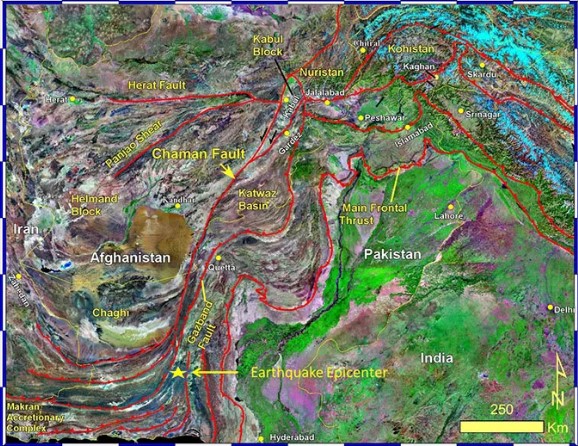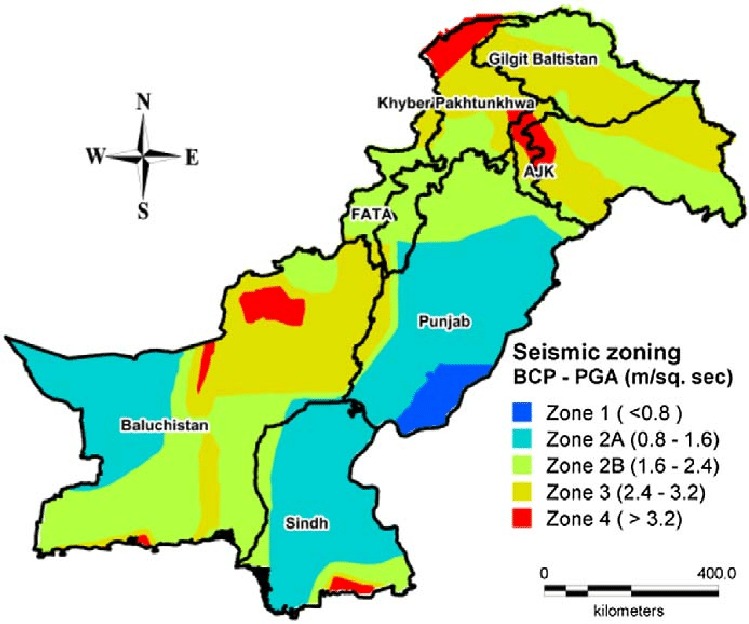Why Pakistan is prone to strong earthquakes
February 8, 2023 03:36 PM

Pakistan is prone to powerful earthquakes owing to their birth to the juncture of three colliding tectonic plates: Indian, Eurasian and Arabian. The Indian and Eurasian plates grind past each other along the Chaman Fault, triggering destructive temblors.
The deadly earthquakes of 2005 and 2013 struck along one of the most hazardous yet poorly studied tectonic plate boundaries in the world.
The earthquakes were likely centred on a southern strand of the Chaman Fault. In 1935, an earthquake on the northern Chaman Fault killed more than 30,000 people and destroyed the town of Quetta. It was one of the deadliest quakes ever in Southeast Asia.
Earthquakes along the Chaman Fault are more frequent in the north than in the south.
Similar to California's San Andreas Fault or Turkey's East Anatolian Fault, in some spots, the massive plate boundary is not a single fracture. In southern Pakistan, the Chaman Fault splits into more than one strand, weaving a braid of many smaller faults. The differences between north and south influence the number of earthquakes. In the past 40 years, only one quake bigger than magnitude 6.0 has jiggled southern Pakistan.

Altogether, the strike-slip Chaman Fault spans more than 500 miles, crossing through Afghanistan and Pakistan. Strike-slip faults move each side of the fracture mostly parallel to each other.
In the north, near the town of Chaman where India jabs a knuckle into Pakistan, the fault has zipped along at 33 millimeters (1.3 inches) every year for the past 38,000 years, according to a study published in the journal Tectonophysics.
The ongoing tectonic crash in Pakistan also helps create the mud volcanoes that pop up after earthquakes there.
Pakistan has been divided into five distinctive zones concerning the seismic hazard including; Zone 1, Zone 2A, Zone 2B, Zone 3, and Zone 4.
Each of these zones represents a different level of seismic hazard with respect to the peak ground acceleration (PGA) values, and potential damage to the elements at risk
Sindh, Punjab and Azad Jammu & Kashmir lie on the north-western edge of the Indian plate in South Asia. Hence this region is prone to violent earthquakes, as the two tectonic plates collide.
The geographical location of Pakistan lies between 24°N to 37°N latitude and 61°E to 75.5°E longitude. Some of the important faults in Pakistan include, Chaman, Main Karakoram Thrust (MKT), Main Mantle Thrust (MMT), Main Boundary Thrust(MBT) and Margalla (GSP 1988; NESPAK 2006). The Chaman Thrust fault system is a continuation on land of an extensive transform fault system in the Arabian Sea known as the Owen Fracture (a transform fault) Zone. The fault system is a major fracture which begins in the Baluchistan province of the country.

The ChamanThrust fault system extends along Pakistan’s frontier with Afghanistan. It begins near Kalat, in the northern Makran range, passes near Quetta and continues in a north-northeastern direction to Kabul, Afghanistan – after branching off to form the Main Karakorum Thrust (MKT) system. The Main Mantle Thrust (MMT) system parallels the Chaman fault on the east side of the Pishin basin. Both the MKT and the MMT turn eastward in the Hazara-Kashmir syntaxial bend near the Main Boundary Thrust (MBT), the region of major tectonic plate collision. Similarly, a major fault along the offshore Makran coast (Baluchistan and Sindh provinces) is the result of active zone where major earthquakes have occurred in the past. This zone forms the boundary of the Arabian plate subducting under the Iranian micro-plate (Yadav et al. 2012). How-ever, the seismicity of the Makran region is relatively low compared to the neigh-bouring regions, which have been devastated regularly by large earthquakes; although in frequent, large earthquakes do occur from time to time along the Makran coast. For example, the huge earthquake of 28 November 1945 generated a destructive tsunami in the northern Arabian Sea. The catastrophic devastation caused by the earthquake of 8 October 2005 in Pakistan necessitated the need for monitoring the tectonic plates movements, redefining the seismic zoning and updating of the building codes in the country (NESPAK 2006; NORSAR and PMD 2006; Bhatti et al. 2011). Thus, the main focus of this study is to locate and characterize active and potentially active geologic structures that are faults and/or segments of faults. These structures represent a potential seismic source that could influence the seismic hazard at the specific site. The seismic hazard analysis will be based on topographical, geological and seismological history of the region, including recent and historical seismicity, supplemented with seismological information. The results of this study will be used to improve the understanding of the geodynamics of the region, such as earthquake rupture processes, mode of faulting, inferred stress field, etc.534 M.J. Butt et al.
Pakistan geologically overlaps both the Eurasian and Indian tectonic plates. Balochistan, the Federally Administered Tribal Areas, Khyber Pakhtunkhwa and Gilgit-Baltistan provinces lie on the southern edge of the Eurasian Plate on the Iranian Plateau. Sindh, Punjab and Azad Jammu & Kashmir provinces lie on the north-western edge of the Indian plate in South Asia. Hence this region is prone to violent earthquakes, as the two tectonic plates collide.






 Maryam Nawaz can wear uniform!
Maryam Nawaz can wear uniform! Madiha Rizvi ties the knot again
Madiha Rizvi ties the knot again Zara Noor Abbas inspired by Rani Mukerji
Zara Noor Abbas inspired by Rani Mukerji Here is all about Madiha Rizvi’s second husband
Here is all about Madiha Rizvi’s second husband Two patients die, injuries of 12 others multiplied after roof collapse at Gujrat hospital
Two patients die, injuries of 12 others multiplied after roof collapse at Gujrat hospital Humayun Saeed and Saboor Aly under fire for close interaction in public
Humayun Saeed and Saboor Aly under fire for close interaction in public





